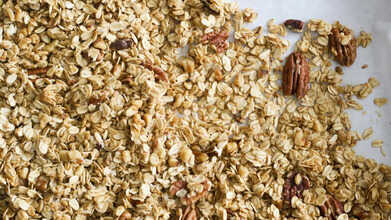- Health Conditions A-Z
- Health & Wellness
- Nutrition
- Fitness
- Health News
- Ayurveda
- Videos
- Medicine A-Z
- Parenting
- Web Stories
Human Kibble Is Trending—But How Nutritious Is It?

Credit: Canva
The concept of "kibble," typically associated with the pellet-like blend of meats and grains fed to pets since the early 20th century, is now being reimagined for human consumption. A viral TikTok video, recently, sparked interest in what some are calling "human kibble," a simple, nutrient-dense meal option.
Earlier this year, popular creator @myfoodisme2 shared his experience of consuming a mix of unflavored chopped vegetables, chicken breast, tofu, grains, and legumes for five years. The video details his process of cutting, cooking, and combining these ingredients in a large bowl, resulting in a concoction reminiscent of animal feed. According to the creator, this mixture provides balanced nutrition with minimal effort, and his video has since inspired other users to try the "human kibble" trend.
Despite the growing popularity, experts and viewers have mixed opinions about adopting this dietary habit. While some argue that a daily, pre-prepared meal can simplify nutrition and help achieve dietary goals, others caution against its potential drawbacks.
Wan Na Chun, MPH, RD, CPT, owner of One Pot Wellness in Indianapolis, warns against the monotony of such a diet. “Eating the same foods for long periods can lead to boredom, dissatisfaction, and even nutrient gaps if the meals aren’t properly balanced and varied,” she said.
Emma Laing, PhD, RDN, director of dietetics at the University of Georgia and spokesperson for the Academy of Nutrition and Dietetics, acknowledges the nutritional potential of @myfoodisme2’s meal. With 19 whole foods in the bowl, she sees the value in a meal pattern that emphasizes vegetables and beans, both of which are under-consumed in many diets.
“If people are inspired to add foods to their diet that they do not normally eat by following this trend, it could be a positive step towards filling nutrient gaps,” Laing said. For individuals struggling to incorporate vegetables into their meals, finely chopping and mixing them with other ingredients can be a practical solution, she added.
However, the predictability of human kibble could backfire. According to Chun, consuming the same blend daily may lead to nutrient imbalances if it is not carefully planned. “Rotating through different food groups and incorporating a variety of whole grains, legumes, seafood, and spices could improve both nutrient diversity and palatability,” Laing recommended.
Chun also emphasized the importance of sufficient sodium intake, particularly for those with active lifestyles, as excessive sweating can lead to electrolyte loss. Adding seasoning like salt or a nutrient-rich spice blend could help maintain essential mineral levels.
Storage and food safety are also potential concerns. While @myfoodisme2’s massive bowl may last him several days, the USDA advises that leftovers should be consumed within four days to avoid the risk of foodborne illnesses.
Beyond nutrition and safety, the terminology of "kibble" may affect the way people perceive their meals. “The language we use about food matters,” Chun said. “Referring to meals as ‘kibble’ could make eating feel mechanical and detract from the cultural and social aspects of food.”
In summary, while human kibble may offer a convenient and nutritionally dense option for some, it is not a universally recommended dietary approach. Laing advises caution for those with higher caloric needs, such as athletes, and notes that sudden dietary shifts could cause digestive discomfort.
Ultimately, Laing reminds people that food is more than just fuel. “Food is also a source of culture, connection, and enjoyment,” she said. “For many, a varied and flexible diet is essential for maintaining both satisfaction and nutrition.”
What Is Colloidal Oatmeal And How Can It Help Manage Eczema?

Credits: Canva
For many people, eczema is more than dry, itchy skin; it’s an ongoing struggle that affects overall well-being, including mood, social life, and sleep. Parents of children with eczema often spend nights trying to stop persistent scratching, while adults frequently feel self-conscious at work or in public when flare-ups are visible.
The condition also brings financial strain from treatments, frequent doctor visits, and emotional stress. In India, eczema is worsened by the climate, pollution, and regular use of harsh or fragranced skincare products, making sensitive skin even more prone to irritation. Gentle, science-backed care is essential, not just helpful, to manage skin conditions that affect over 30–40% of Indians.
We spoke to Dr Preethi Nagaraj, Medical Director and Senior Dermatologist at Twacha Skin and Hair Clinic, Kochi, to learn more.
What Is Eczema and Its Ripple Effects?
Eczema, or atopic dermatitis, typically appears as dry, itchy, and red patches on the skin. While some people may experience mild irritation, others face severe flare-ups that disrupt daily life. But eczema is more than a skin condition, it can affect concentration, mental health, and sleep. Dr Nagaraj explained that this can make it harder for children to focus at school and cause adults to miss work or social events. Recognizing these broader effects shifts the focus from simply treating the skin to supporting the individual as a whole.
Why the Skin Barrier Matters
The main reason eczema develops is a compromised skin barrier. A healthy barrier relies on ceramides, fatty acids, and cholesterol to retain moisture and block irritants. When ceramides are low, skin loses water quickly and becomes highly sensitive, even with regular moisturization. Genetics also play a role—about one-third of Indian children with hand eczema have filaggrin mutations, weakening their protective layer. That’s why consistent, barrier-focused skincare is essential to keep flare-ups under control.
What Is Colloidal Oatmeal?
Colloidal oatmeal is a fine powder made from whole oat kernels and is used as a skin protectant to soothe itching and irritation. It’s a recognized ingredient that hydrates skin, protects against irritants, and provides antioxidant and anti-inflammatory benefits. It can be used in bathwater or in creams and lotions, according to Healthline.
How Can Colloidal Oatmeal Help Treating Eczema
Colloidal oatmeal isn’t just a breakfast ingredient, it’s been a long-standing skin soother. It contains compounds called avenanthramides that calm inflammation and reduce itchiness. Beta-glucans form a protective layer to lock in moisture, and oat lipids help repair the skin’s barrier. Research supports these benefits: a study of over 54,000 patients found that not using oatmeal-based emollients increased the likelihood of being prescribed steroid creams by more than 21%. Another analysis showed that infants who regularly used oatmeal-based products were less likely to develop eczema. Gentle, effective, science-backed oats remain a staple for sensitive skin care.
Ceramides: Repairing What Eczema Steals
Dr Nagaraj explained that ceramides are natural skin fats that hold cells together and maintain hydration. Low ceramide levels make eczema-prone skin prone to cracking, roughness, and sensitivity to triggers. The good news? Oat oil can boost ceramide production in the skin by up to 70%. Combining ceramides with colloidal oatmeal in a moisturizer creates a powerful duo: one soothes and hydrates, while the other strengthens the skin’s protective layer.
Making Science-Backed Skincare Work Every Day
For sensitive or eczema-prone skin, Indian dermatologists often recommend gentle, fragrance-free products enriched with colloidal oatmeal. Using these regularly is preventive, not a luxury. Consistent care can mean fewer sleepless nights for families, while adults regain confidence at work and in social settings. The key to preventing flare-ups is a steady, regular routine.
Eczema can take a physical and mental toll, but it doesn’t have to control life. Colloidal oatmeal, supported by tradition and science, provides gentle, effective relief, while ceramides maintain the skin’s strength. Together, they reduce sensitivity to daily triggers and help break the cycle of flare-ups. The takeaway is simple: small, consistent steps in skincare can have a major impact. With the right approach, patients and families can reclaim comfort, confidence, and quality of life, making colloidal oatmeal a trusted ally on the path to healthier skin.
Is Bubble Tea Putting Your Health at Risk? Experts Warn About Lead Exposure

Credits: Canva
A trendy drink that’s become a social media favorite may now have fans thinking twice, after questions were raised about one key ingredient.
Bubble tea, also called boba or pearl milk tea, first appeared in Taiwan in the 1980s. It’s usually made with tea, milk or creamer, a sweetener, and, of course, the signature chewy tapioca pearls.
While its colorful, Instagram-worthy appeal has made it popular around the world, recent safety tests from Consumer Reports suggest there could be reason for concern.
Also Read: mRNA COVID Vaccines Found To Help Cancer Patients Live Longer: Can This Be The Ultimate Cancer Cure?
Boba Tea Contains Lead?
Bubble tea, the Taiwanese drink made of black tea, milk, sugar, and chewy tapioca pearls, has won fans worldwide since its debut in the 1980s. But recent findings suggest it may deserve a closer look.
A Consumer Reports investigation in the US found high lead levels in some bubble tea products, echoing earlier concerns about cassava-based foods. The tapioca pearls, the drink’s signature “bubbles,” are made from cassava starch, which can absorb lead and other heavy metals from the soil as the plant grows.
Why Are Tapioca Pearls Harmful?
Lead is naturally present in the Earth’s crust, and much of the world’s soil contains significant contamination. Many fruits and vegetables, including cassava, can absorb heavy metals during growth.
Consumer Reports tested tapioca pearls from popular bubble tea chains, Gong Cha and Kung Fu Tea, as well as packaged boba products from Trader Joe’s and WuFuYuan. Every sample contained some lead. Thankfully, none exceeded the levels that Consumer Reports considers concerning, and none had dangerous levels of arsenic, cadmium, or mercury in a single serving.
Also Read: World Polio Day: How the Polio Vaccine Became a Lifesaving Shield Against a Global Disease
“These levels weren’t high enough for us to advise people to completely avoid bubble tea,” said James E. Rogers, PhD, director of food safety research and testing at Consumer Reports.
“However, this wasn’t a comprehensive survey of the boba and bubble tea market. The fact that three out of four samples contained more than half of our level of concern for lead in a single serving is a strong reminder that bubble tea should be enjoyed occasionally, rather than as an everyday drink.”
Beyond heavy metals, the starchy composition of tapioca pearls can pose other risks. Eating large amounts may slow stomach emptying, a condition called gastroparesis, or even cause blockages. Symptoms can include nausea, vomiting, and abdominal pain, and people with already slow digestion may be particularly affected.
Bubble Tea and Kidney Health
Bubble tea can also impact kidney health. In 2023, Taiwanese doctors removed more than 300 kidney stones from a 20-year-old woman who reportedly drank bubble tea in place of water. Ingredients such as oxalate and high phosphate levels can contribute to stone formation, though this extreme case likely reflects unusually high consumption.
Jason Tsou, General Manager at WuFuYuan’s parent company, Shanghai ZhouShi Foodstuffs, said the company routinely tests its products for lead through an accredited laboratory. Following these recent findings, they have introduced stricter standards to ensure safety, as per New York Post.
Can L-Theanine Really Make You Focus Better? What Science Says About the ‘Calm but Alert’ Effect

Credits: Canva
If you often struggle with stress or restless nights, a warm cup of tea is likely your go-to for calming down. Tea’s comforting reputation isn’t just tradition, studies suggest it can support heart health, aid digestion, and more. One key component behind these benefits is L-theanine, an amino acid found in tea leaves. Available as a supplement, L-theanine is thought to help reduce anxiety, improve sleep, and even enhance focus.
It is gaining popularity as a supplement for enhancing focus and relaxation. But does it live up to the hype? Here's what recent research reveals about its effects on attention, reaction time, and cognitive performance.
What Is L-Theanine?
L-theanine is an amino acid naturally found in tea leaves, especially in green tea and loose-leaf varieties, and is believed to offer several health benefits. But first, it helps to understand what amino acids are and why they matter.
Amino acids are the building blocks of proteins and, ultimately, life itself, as per Healthline. They are molecules used by all living organisms to make proteins. Humans need 20 different amino acids to function properly, 11 of which are essential and must come from food.
Although L-theanine is not essential for survival, research has explored its effects on brain function and cognitive performance.
You can consume L-theanine by drinking teas such as green tea, white tea, or matcha, or by taking it in supplement form, including tablets and capsules.
Can L-Theanine Really Make You Focus Better?
Yes, several studies suggest that L-Theanine can enhance focus and attention. For instance, a 2011 study published in ScienceDirect found that L-Theanine improved attention performance and reaction time in individuals prone to high anxiety.
Additionally, a 2021 study in PubMed Central reported that a single dose of L-Theanine reduced reaction time to attention tasks and increased the number of correct answers in working memory tasks among middle-aged adults.
PMC
L-Theanine appears to have a positive impact on reaction time. A 2025 study published in PubMed found that a 200 mg dose of L-Theanine reduced hit reaction time by 38.65 milliseconds in sleep-deprived individuals during a traffic-related visual recognition task.
PubMed
L-Theanine Effect with Caffeine
When combined with caffeine, L-Theanine may offer enhanced cognitive benefits. A 2010 study in PubMed indicated that the combination of 97 mg of L-Theanine and 40 mg of caffeine improved accuracy during task switching and reduced self-reported tiredness in young adults.
PubMed
L-Theanine: Is It Safe to Use?
L-Theanine is generally considered safe when consumed in moderate amounts, such as those found in tea or supplements. However, as with any supplement, it's advisable to consult with a healthcare provider before starting, especially if you have underlying health conditions or are taking other medications.
L-Theanine shows promise as a natural supplement to enhance focus and reaction time, particularly when combined with caffeine. While more research is needed to fully understand its long-term effects, current studies suggest it can be a useful tool for those seeking improved cognitive performance without the jitteriness associated with other stimulants.
Disclaimer: The information provided is based on current research and should not replace professional medical advice.
© 2024 Bennett, Coleman & Company Limited

